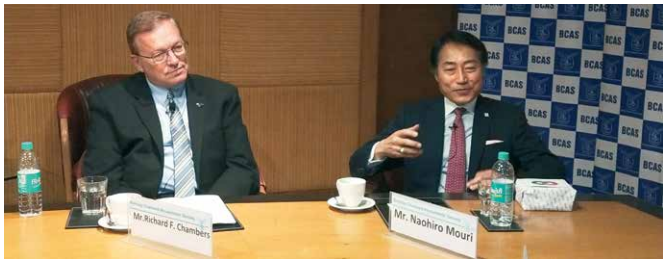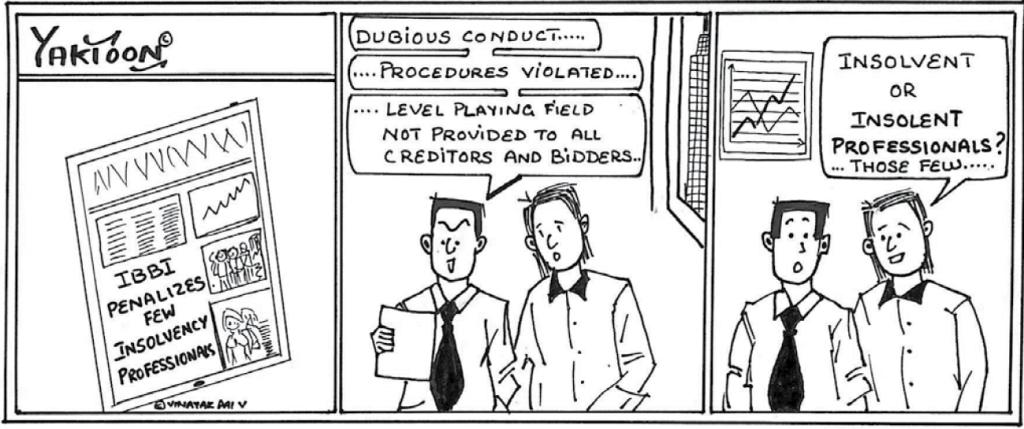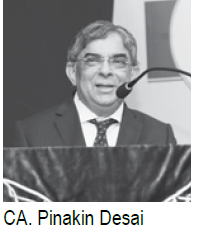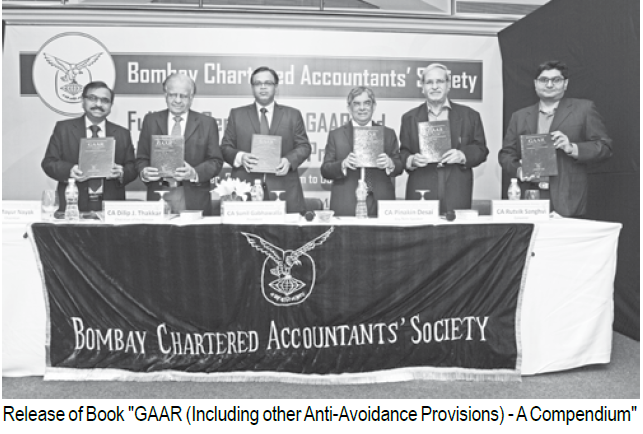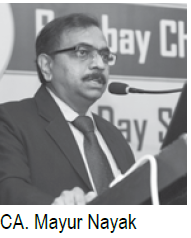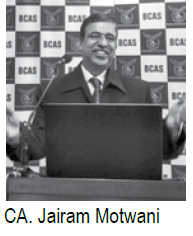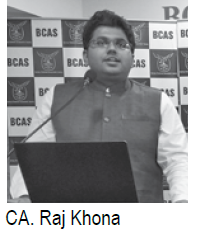ILLUSTRATION
OF AUDIT REPORT WITH QUALIFIED OPINION AND KEY AUDIT MATTERS (WHERE THE
PREDECESSOR AUDITOR HAD ALSO ISSUED AUDIT OPINION WITH QUALIFICATIONS ON
CERTAIN MATTERS)
FORTIS HEALTHCARE LTD.
(31st March, 2019)
From
Auditors’ Report
BASIS
FOR QUALIFIED OPINION
(a) The matters stated below were also subject
matter of qualification in predecessor auditor’s audit opinion on the
consolidated financial statements as at 31st March, 2018:
(i) As explained in Note 31 of the consolidated
financial statements, pursuant to certain events / transactions, the erstwhile
Audit and Risk Management Committee (ARMC) of the company had initiated an
independent investigation by an external legal firm and special audits by
professional firms on matters relating to systematic lapses / override of
internal controls as described in Note 31 of the consolidated financial
statements. The report has since been submitted and is subject to the limitations
on the information available to the external legal firm and their
qualifications and disclaimers as described in their investigation report.
Additionally, different
regulatory authorities are currently undertaking their own investigations,
details of which are described in Note 31 and Note 32 of the consolidated
financial statements and are stated below:
SEBI has initiated an
investigation in respect of the various issues. On 17th October,
2018, 21st December, 2018, and 19th March, 2019, SEBI
passed orders (orders) and further investigation by regulatory authorities is
continuing. In its orders, SEBI observed that certain inter-corporate deposits
(ICDs) made by Fortis Hospitals Limited (FHsL), a wholly-owned subsidiary of
the company, with certain identified entities were so structured that they seem
to be prima facie fictitious and fraudulent in nature resulting inter
alia in diversion of funds from the group for the ultimate benefit of the
erstwhile promoters (and certain entities controlled by them) resulting in a
misrepresentation in the financial statements of the group in earlier period.
Further, SEBI issued certain directions inter alia directing the company
and FHsL to take all necessary steps to recover Rs. 40,300 lakhs along with the
due interest from the erstwhile promoters and various other entities as
mentioned in the orders. It has also directed the erstwhile promoters and the
said entities to repay the sums due. The aforesaid ICDs were fully provided for
in the books as at 31st March, 2018. SEBI, in its orders, also
directed the erstwhile promoters and the said entities that pending completion
of investigation and till further order, they shall not dispose of or alienate
any of their assets or divert any funds, except for the purpose of meeting
expenses of day-to-day business operations, without the prior permission of
SEBI. Erstwhile promoters have also been directed not to associate themselves
with the affairs of the company in any manner whatsoever till further
directions. The initial directions issued by SEBI have been confirmed by SEBI
in their order dated 19th March, 2019.
The Serious Fraud Investigation
Office (SFIO), Ministry of Corporate Affairs, u/s 217(1)(a) of the Companies
Act, 2013, inter alia, has initiated an investigation and has been
seeking information in relation to the company, its material subsidiaries,
joint ventures and associates to which, as informed to us, the company has
responded.
Since the investigation and
inquiries carried out by regulators as aforesaid are currently ongoing, the
need for additional procedures / inquiries, if any, and an overall assessment
of the impact of the investigations on the financial statements is yet to be
concluded.
Based on investigations carried
out by an external legal firm, orders by SEBI and other information available
currently, as per the management all identified / required adjustments /
disclosures arising from the findings in the investigation report and the
orders by SEBI, were made in the consolidated financial statements for the year
ended 31st March, 2018.
Matters included in the
investigation report (but not limited to) and highlighted by the predecessor
auditor in their audit report for the year ended 31st March, 2018,
are as below:
Provisions against the
outstanding ICDs amounting to Rs. 44,503 lakhs (including interest accrued
thereon of Rs. 4,260 lakhs), provision of Rs. 5,519 lakhs towards amounts paid
as security deposit, advances towards lease of office space and expenditure
incurred towards capital work in progress and Rs. 2,549 lakhs towards property
advance (including interest accrued thereon of Rs. 174 lakhs) due to
uncertainty of recovery of these balances (refer to Note 29 and Note 30 of the
consolidated financial statements).
The company through its overseas
subsidiaries sold its investment held in a fund at a discount (money was
received on 23rd April 2018) which was recorded as a loss in the
consolidated financial statements for the year ended 31st March,
2018. In the absence of sufficient information available, the rationale to
demonstrate the reasonability of the discount was not established [refer to
Note 30(c) and 31(b) of the consolidated financial statements].
Certain past transactions as
mentioned in Note 31 of the consolidated financial statements may have been
prejudicial to the group.
No additional adjustments /
disclosures were required to be made in the consolidated financial statements
for the year 31st March, 2019 in respect of the above.
As explained
in Note 9(5) and Note 31(e) of the consolidated financial statements, related
party relationships prior to loss of control of erstwhile promoters / directors
in the year ended 31st March, 2018 were identified by the management
taking into account the information available with the management and including
the findings and limitations in the investigation reports. In this regard,
specific declarations from the erstwhile directors / promoters, especially
considering the substance of the relationship rather than the legal form, were
not available. Therefore, the possibility cannot be ruled out that there may be
additional related parties of erstwhile promoters / directors whose
relationships may not have been disclosed to the group and, hence, not known to
the management.
Further, as
explained in Note 14 of the consolidated financial statements, a civil suit was
filed by a third party against various entities including the company relating
to ‘Fortis, SRL and La-Femme’ brands. The company has received four demand
notices aggregating to Rs. 25,344 lakhs in respect of this civil suit. The
allegations made by the third party have been duly responded to by the company,
denying (i) execution of any binding agreement with the third party; and (ii)
liability of any kind whatsoever. Based on legal advice of the external legal
counsel, the management believes that the claims are without legal basis and
not tenable. The matter is currently subjudice.
Due to the
ongoing nature of the various regulatory inquiries / investigations, we are
unable to comment on the adjustments / disclosures which may become necessary
as a result of further findings of the ongoing regulatory investigations on the
consolidated financial statements, including completeness / accuracy of the
related party transactions which relate to or which originated before 31st
March, 2018, the regulatory non-compliances, if any, and the consequential
impact, if any, on the consolidated financial statements.
(ii) As explained in Note 29 and Note 30, during
the year ended 31st March, 2018 interest income of Rs. 4,434 lakhs
comprising Rs. 4,260 lakhs (on the outstanding ICDs given) and Rs. 174 lakhs
(relating to property advance) had been recognised. A provision was, however,
created against the entire amount in the year ended 31st March, 2018
and the provision was disclosed as an exceptional item. The recognition of the
aforesaid interest income as at 31st March, 2018 on doubtful ICDs
and property advance is not in compliance with Ind AS 18 ‘Revenue’ (as it does
not meet the recognition criteria) and consequently interest income and the
provision for doubtful interest disclosed as exceptional items (net) are
overstated to that extent. It had no impact on loss for the year ended 31st
March, 2018.
(iii) As explained in Note 34 of the consolidated
financial statements, during the year ended 31st March, 2018, the
company having considered all necessary facts and taking into account external
legal advice, concluded that it had paid amount aggregating to Rs. 2,002 lakhs
to the erstwhile Executive Chairman during his tenure (ended during the year
ended 31st March, 2018) in excess of the amounts approved by the
Central Government u/s 197 of the Companies Act, 2013 for his remuneration and
other reimbursements. This is accordingly a non-compliance with
the provisions of section 197 of the Companies Act, 2013. In the current year,
the company has taken requisite actions to
recover this amount. Due to the uncertainty involved in recoverability of the
said amounts, a provision for this amount has also been recorded.
(b) The
group has recorded a cumulative financial liability as at 31st
March, 2019 of Rs. 118,000 lakhs (included under ‘other current financial
liabilities’) by debiting ‘other equity’ in respect of put option available
with certain non-controlling shareholders of SRL Limited [refer to Note 12(b)
of the consolidated financial statements]. The group has not quantified the
liability relating to previous periods and, therefore, we are unable to comment
on the impact of such liability for previous periods.
We conducted
our audit in accordance with the Standards on Auditing (SAs) specified u/s
143(10) of the Act. Our responsibilities under those SAs are further described
in the Auditor’s Responsibilities for the Audit of the Consolidated
Financial Statements section of our report. We are independent of the group
in accordance with the Code of Ethics issued by the Institute of Chartered
Accountants of India and we have fulfilled our other ethical responsibilities
in accordance with the provisions of the Act. We believe that the audit
evidence we have obtained is sufficient and appropriate to provide a basis for
our qualified opinion.
EMPHASIS OF MATTER
We draw
attention to the following matters in the Notes forming part of the
consolidated financial statements:
(a) Note
14(II) relating to outcome of income tax assessments in respect of Escorts
Heart Institute and Research Centre Limited (EHIRCL), one of the subsidiaries
in the group, regarding amalgamation of two societies and its subsequent
conversion to EHIRCL;
(b) Note
14(II) relating to the outcome of the civil suit / arbitrations with regard to
termination of certain land leases allotted by Delhi Development Authority
(DDA) and the matter related to non-compliance with the order of the Honourable
High Court of Delhi in relation to provision of free treatment / beds to the
poor by EHIRCL;
(c) Note
14(III) regarding matter relating to termination of hospital lease agreement of
Hiranandani Healthcare Private Limited, one of the subsidiaries in the group,
by Navi Mumbai Municipal Corporation (NMMC) vide order dated 18th
January, 2018.
Based on the
advice given by external legal counsel, the likelihood of outflow in the above
litigations is remote and accordingly no provision / adjustment has been
considered necessary by the management with respect to the above matters in the
consolidated financial statements.
Our opinion
is not modified in respect of these matters.
KEY AUDIT MATTERS
Key audit
matters are those matters that, in our professional judgement, were of most
significance in our audit of the consolidated financial statements of the
current period. These matters were addressed in the context of our audit of the
consolidated financial statements as a whole, and in forming our opinion
thereon, and we do not provide a separate opinion on these matters.
In addition
to the matters described in the ‘Basis for Qualified Opinion’ paragraphs, we
have determined that the following are the key audit matters:
|
The
key audit matter
|
How
the matter was addressed in our audit
|
|
Accounting for
acquisitions
|
|
|
As explained in Note 26
of the consolidated financial statements, the group acquired business of RHT
Health Trust (formerly known as Religare Health Trust) for a consideration of
Rs. 466,630 lakhs and on the basis of the preliminary purchase price
allocation recorded
goodwill of Rs. 180,070 lakhs
The contractual
arrangements for such transactions can be complex and require management to
apply judgement in determining whether a transaction represents an
acquisition of an asset or a business combination and there are estimates and
judgements made in any such purchase price allocation
|
In view of the
significance of the matter we evaluated the accounting for the acquisition,
including:
Assessed
the judgements applied in determining whether this acquisition represented an
acquisition of an asset or a business combination. This involved assessing
whether or not the entities and the assets acquired constitute the carrying
on of a business, i.e., whether there are inputs and processes applied to
those inputs that have the ability to create outputs;
Inspected the
agreements to determine whether the appropriate intangible assets (including
termination of pre-existing relationship) have been identified and that no
unusual terms exist that have not been accounted for;
The audit procedures in
relation to consideration payable, accounting of fair valuation of the
separately identifiable acquired assets and assumed liabilities; and
|
|
|
Tested the valuation
assumptions such as projected cash flows growth, discount and tax rates by
reviewing assumptions used in such calculations and recalculating on sample
basis
In doing so we have
involved independent valuation specialists to assist us in carrying out the
aforesaid procedures as considered appropriate
We have also evaluated
the accounting and respective disclosures made in the consolidated financial
statements
|
|
Goodwill and
investment
|
|
|
As set out in Note
6(ii) and 6(iv), the group carries goodwill of Rs. 372,076 lakhs and
investments in associates and joint ventures of Rs. 19,031 lakhs. Management
performs an annual impairment review of goodwill as at 31st March.
Investments are tested for impairment in case an indicator of potential
impairment is identified
There are judgements
used in this, such as forecast cash flows, discount rates and growth rates
|
We have assessed the
group’s current and forecast performance and considered whether any other
factors exist that would suggest that the goodwill / investment is impaired.
We have performed the
following procedures:
Challenged management’s
identification of Cash Generating Units (CGUs) against our understanding of
the business and the definition as set out in the accounting standards;
Assessed the
appropriateness of the calculation of the value in use of each CGU and the
associated headroom, performing recalculations to test the mechanical
accuracy of those amounts;
Forecast inputs and
growth assumptions were compared against historical trends to assess the
reliability of management’s forecast, in addition to comparing forecast
assumptions to external market analysis;
With the assistance of
specialists, we compared the discount rate applied to the future cash flows
and benchmarked it against other companies in the industry; and
Performed sensitivity
analysis
In doing so we have
involved our valuation specialists to assist us in carrying out aforesaid
procedures as considered appropriate
We have also evaluated
the accounting and respective disclosures made in the consolidated financial
statements
|
|
Legal matters
|
|
|
There are a number of
threatened and actual legal, regulatory and tax cases against the group.
These include those relating to land and related commitments, tax matters,
claims made by or against the group on account of medical matters and other
civil suits, etc. There is a high level of judgement required in assessing
consequential impact and disclosures thereof on the consolidated financial
statements
Refer to Note 3 –
Critical estimates and judgements; Note 6(xx) – Provisions; and Note 13 –
Contingent liabilities and legal proceedings
|
Our procedures included
the following:
Testing key controls
surrounding litigation, regulatory and tax cases;
External legal opinions
obtained by management and independent confirmations obtained by us;
Reading correspondences
including those of subsequent period;
Discussing open matters
with the management including, but not limited to, company legal counsel, tax
teams, regional and financial teams; and
Assessing and
challenging management’s conclusions through understanding precedents set in
similar cases
Based on the evidence
obtained, management’s assessment of such legal, regulatory and tax matters,
the provision carried in the books of accounts in respect of such matters as
on 31st March, 2019 (while noting the inherent uncertainty of such
matters) and related disclosures seem to be reasonable
|
Report on Other
Legal and Regulatory Requirements
1. As regards the matters to be
inquired by the auditors in terms of section 143(1) of the Act, we report, to
the extent applicable, as follows:
(a) As explained in Note 29 and
Note 31(d)(i) of the consolidated financial statements, FHsL, a wholly-owned
subsidiary of the company, has granted loans in the form of ICDs to three
borrower companies which were stated to have been secured at the time of grant
on 1st July, 2017. However, it has been noted in the investigation
report that:
(i) there were certain systemic
lapses and override of internal controls including shortcomings in executing
documents and creating a security charge. The charge was later on created in
February, 2018 for the ICDs granted on 1st July, 2017 while the
company / FHsL was under financial stress; and
(ii) there were certain systemic
lapses in respect of the assignment of the ICDs and subsequent termination of
the arrangement, viz., no diligence was undertaken in relation to assignment,
it was not approved by the Treasury Committee, and was antedated. The Board of
the subsidiary took note of the same only in February, 2018.
Further, we note from the
investigation report that the external legal firm was unable to assess as to
whether the security (charge) is realisable considering the nature of assets
held by the borrower companies.
In view of the above, we are
unable to comment whether aforesaid loans and advances made by the wholly-owned
subsidiary on the basis of security have been properly secured or whether they
are prejudicial to the interests of the group.
(b) In respect of the ICDs placed,
the investigation report has stated that a roll-over mechanism was devised
whereby the ICDs were repaid by cheque by the borrower companies at the end of
each quarter and fresh ICDs were released at the start of succeeding quarter
under separately executed ICD agreements. Further, in respect of the roll-overs
of ICDs placed on 1st July 2017 with the borrower companies, FHsL
utilised the funds received from the company for the purposes of effecting
roll-over. We are unable to determine whether these transactions in substance
represent book entries or whether they are prejudicial to the interests of the
group as these were simultaneously debited and credited to the bank statement.
However, as explained in Note 29
to the consolidated financial statements, the company’s management has fully
provided for the outstanding balance of the ICDs and the interest accrued
thereon as at 31st March, 2018.
(c) As explained in Note
31(d)(iv), during the year, the company through its subsidiary (i.e., Escorts
Heart Institute and Research Centre Limited or EHIRCL), acquired 71% equity
interest in Fortis Healthstaff Limited at an aggregate consideration of Rs.
3.46 lakhs. Subsequently, EHIRCL advanced a loan to Fortis Healthstaff Limited,
which was used to repay the outstanding unsecured loan amount of Rs. 794.50
lakhs to a promoter group company. Certain documents suggest that the loan
repayment by Fortis Healthstaff Limited and some other payments to the promoter
group company were ultimately routed through various intermediary companies and
used for repayment of the ICDs / vendor advance to FHsL / company.
Further as explained in Note
31(i), the company through its subsidiary (FHsL) acquired equity interest in
Fortis Emergency Services Limited from a promoter group company. On the day of
the share purchase transaction, FHsL advanced a loan to Fortis Emergency
Services Limited which was used to repay an outstanding unsecured loan amount
to the said promoter group company. It may be possible that the loan repayment
by Fortis Emergency Services Limited to the said promoter group company was
ultimately routed through various intermediary companies and was used for
repayment of the ICDs / vendor advance to FHsL.
With regard to the above
acquisitions, we are informed that pre-approval from the Audit Committee was
obtained for acquiring the equity interest, but not for advancing the loans to
these subsidiaries. Further, we understand that the aggregate of the amounts
paid towards acquisition of shares and the loans given were substantially
higher than the enterprise value of these companies at the time of acquisition,
as determined by the group.
In view of the above, we are
unable to determine whether these transactions are prejudicial to the interests
of
the group.
……
3. With respect to the other
matters to be included in the Auditor’s Report in accordance with Rule 11 of
the Companies (Audit and Auditor’s) Rules, 2014, in our opinion and to the best
of our information and according to the explanations given to us and based on
the consideration of the reports of the other auditors on separate financial
statements of the subsidiaries, associates and joint ventures, as noted in the
‘other matters’ paragraph:
(a) Except for the effects /
possible effects of matters described in paragraph (a)(i) of the ‘Basis for
Qualified Opinion’ section above, the consolidated financial statements
disclose the impact of pending litigations as at 31st March, 2019 on the
consolidated financial position of the group, its associates and joint ventures.
Refer Note 13 to the consolidated financial statements.
(b) Except for effects / possible
effects of the matters described in paragraph (a) of the ‘Basis for Qualified
Opinion’ section above, provision has been made in the consolidated financial
statements, as required under the applicable law or Ind AS, for material
foreseeable losses, if any, on long-term contracts including derivative
contracts. Refer Note 12(b), 6(xx) and 12(d) to the consolidated financial
statements.
(c) There were no amounts which
were required to be transferred to the investor education and protection fund
by the group. Refer Note 12(e) of the consolidated financial statements.
(d) The
disclosures in the consolidated financial statements regarding holdings as well
as dealings in specified bank notes during the period from 8th
November, 2016 to 30th December, 2016 have not been made in the
financial statements since they do not pertain to the financial year ended 31st
March, 2019.
From
Notes to Accounts
31. Investigation initiated by
the erstwhile Audit and Risk Management Committee:
(a) During the previous year
there were reports in the media and inquiries from, inter alia, the
stock exchanges received by the company about certain inter-corporate loans
(ICDs) given by a wholly-owned subsidiary of the company. The erstwhile Audit
and Risk Management Committee of the company in its meeting on 13th February,
2018 decided to carry out an independent investigation through an external
legal firm on this matter;
(b) The
terms of reference of the investigation, comprised: (i) ICDs amounting to a
total of Rs. 49,414 lakhs (principal), placed by the company’s wholly-owned
subsidiary, FHsL, with three borrowing companies as on 1st July,
2017 (refer Note 29 above); (ii) the assignment of these ICDs to a third party
and the subsequent cancellation thereof as well as evaluation of legal notice
(now a civil suit) received from such third party (refer Notes 14I and 29
above); (iii) review of intra-group transactions for the period commencing FY
2014-15 and ending on 31st December, 2017; (iv) investments made in
certain overseas funds by the overseas subsidiaries of the company [i.e.,
Fortis Asia Healthcare Pte. Ltd, Singapore and Fortis Global Healthcare
(Mauritius) Limited] {refer Note 30(c) above}; (v) certain other transactions
involving acquisition of Fortis Healthstaff Limited (Fortis Healthstaff) from
an erstwhile promoter group company, and subsequent repayment of loan by said
subsidiary to the erstwhile promoter group company;
(c) The investigation report was
submitted to the re-constituted Board on 8th June, 2018;
(d) The re-constituted Board
discussed and considered the investigation report and noted certain significant
findings of the external legal firm, which are subject to the limitations on
the information available to the external legal firm and their qualifications
and disclaimers as described in their investigation report:
(i) While the investigation
report did not conclude on utilisation of funds by the borrower companies,
there are findings in the report to suggest that the ICDs were utilised by the
borrower companies for granting / repayment of loans to certain additional
entities including those whose current and / or past promoters / directors are
known to / connected with the erstwhile promoters of the company;
(ii) In terms of the relationship with the
borrower companies, there was no direct relationship between the borrower
companies and the company and / or its subsidiaries during the period December,
2011 to 14th December, 2017 (these borrower companies became related
parties from 15th December, 2017). The investigation report has made
observations where erstwhile promoters were evaluating certain transactions
concerning certain assets owned by them for the settlement of ICDs, thereby
indirectly implying some sort of affiliation with the borrower companies. The
investigation report has observed that the borrower companies could possibly
qualify as related parties of the company and / or FHsL, given the substance of
the relationship. In this regard, reference was made to Indian Accounting
Standards dealing with related party disclosures, which states that for
considering each possible related party relationship, attention is to be
directed to the substance of the relationship and not merely the legal form;
Objections on record indicate
that management personnel and other persons involved were forced into
undertaking the ICD transactions under the repeated assurance of due repayment
and it could not be said that the management was in collusion with the
erstwhile promoters to give ICDs to the borrower companies. Relevant documents
/ information and interviews also indicate that the management’s objections
were overruled. However, the former Executive Chairman of the company, in his
written responses, has denied any wrongdoing, including override of controls in
connection with grant of the ICDs;
(iii) Separately, it was also noted in the Investigation Report that the
aforesaid third party to whom the ICDs were assigned has also initiated legal
action against the company. (Refer Note 29). Whilst the matter was included as
part of the terms of reference of the investigation, the merits of the case
cannot be reported since the matter was subjudice;
(iv) During the previous year ended 31st March, 2018, the
company through its subsidiary (Escorts Heart Institute and Research Centre
Limited or EHIRCL), acquired 71% equity interest in Fortis Healthstaff Limited
at an aggregate consideration of Rs. 3.46 lakhs. Subsequently, EHIRCL advanced
a loan to Fortis Healthstaff Limited which was used to repay the outstanding
unsecured loan amount of Rs. 794.50 lakhs to an erstwhile promoter group
company. Certain documents suggest that the loan repayment by Fortis
Healthstaff Limited and some other payments to the erstwhile promoter group
company may have been ultimately routed through various intermediary companies
and used for repayment of the ICDs / vendor advance to FHsL / EHIRCL. Further,
the said loan advanced by EHIRCL to Fortis Healthstaff Limited was impaired in
the books of accounts of EHIRCL due to anticipated chances of non-recovery
during the year ended 31st March, 2019;
(v) The investigation did not cover all related party transactions
during the period under investigation and focused on identifying undisclosed
parties having direct / indirect relationship with the erstwhile promoter
group, if any. In this regard, it was observed in internal correspondence
within the company that transactions with certain other entities have been
referred to as related party transactions. However, no further conclusions have
been made in this regard;
(vi) Additionally, it was observed in the investigation report that
there were significant fluctuations in the NAV of the investments in overseas
funds by the overseas subsidiaries during a short span of time. Further, like
the paragraph above, in the internal correspondence within the company,
investments in the overseas funds have been referred to as related party
transactions. During the year ended 31st March, 2018 investments
held in the Global Dynamic Opportunity Fund were sold at a discount of 10% with
no loss in the principal value of investments.
OTHER
MATTERS
(e) Related party relationships
as required under Ind AS 24 Related Party Disclosures and the Companies
Act, 2013 were as identified by the management taking into account the findings
and limitations in the investigation report [Refer Notes 31(d)(i), (ii) and
(vi) above] and the information available with the management. In this regard,
in the absence of specific declarations from the erstwhile directors on their
compliance with disclosures of related parties, especially considering the
substance of the relationship rather than the legal form, the related parties
were identified based on the declarations by the erstwhile directors and the
information available through the known shareholding pattern in the entities up
to 31st March, 2018. Therefore, the possibility cannot be ruled out
that there may have been additional related parties whose relationship may not
have been disclosed to the group and, hence, not known to the management;
(f) With respect to the other
matters identified in the investigation report, the Board initiated specific
improvement projects to strengthen the process and control environment. The
projects included revision of authority levels, both operational and financial
and oversight of the Board, review of financial reporting processes, assessment
of secretarial documentation w.r.t. compliance with regulatory requirements and
systems design and control enhancement. The assessment work has been done and
corrective action plans have been implemented. The Board, however, continues to
evaluate other areas to strengthen processes and build a robust governance
framework. Towards this end, it is also evaluating internal organisational
structure and reporting lines, the roles of authorised representatives and
terms of reference of executive committees and their functional role. The
company’s Board of Directors has also initiated an inquiry of the management of
certain entities in the group that were impacted in respect of the matters
investigated by the external legal firm;
(g) It is in the above backdrop
that it is pertinent to mention that during the previous year the company
received a communication dated 16th February, 2018 from the
Securities and Exchange Board of India (SEBI), confirming that an investigation
has been instituted by SEBI in the matter of the company. In the aforesaid
letter, SEBI required the company u/s 11C(3) of the SEBI Act, 1992 to furnish
by 26th February, 2018 certain information and documents relating to
the short-term investments of Rs. 473 crores reported in the media. SEBI had
appointed forensic auditors to conduct a forensic audit, and of collating
information from the company and certain of its subsidiaries. The company / its
subsidiaries furnished all requisite information and documents requested by
SEBI.
In
furtherance of the above, on 17th October, 2018 SEBI passed an ex-parte
interim order whereby it observed that certain transactions were structured by
some identified entities over a certain duration, and undertaken through the
company, which were prima facie fictitious and fraudulent in nature and
which resulted in inter alia diversion of funds from the company for the
ultimate benefit of erstwhile promoters (and certain entities controlled by
them) and misrepresentation in financial statements of the company. Further, it
issued certain interim directions that inter alia directed the company
to take all necessary steps to recover Rs. 40,300 lakhs along with due interest
from erstwhile promoters and various other entities, as mentioned in the order.
More importantly, the said entities had also been directed to jointly and severally
repay Rs. 40,300 lakhs (approximately) along with due interest to the company
within three months of the order. Incidentally, the order also included FHsL as
one of the entities directed to repay the due sums. Pursuant to this, FHsL’s
beneficial owner account had been suspended for debits by the National
Securities Depository Limited and Central Depository Services (India) Limited.
Further, SEBI had also directed the said entities that pending completion of
investigation and till further order, they shall not dispose of or alienate any
of their assets or divert any funds, except for the purposes of meeting
expenses of day-to-day business operations, without the prior permission of
SEBI. The erstwhile promoters have also been directed not to associate themselves
with the affairs of the company in any manner whatsoever till further
directions. Parties named in the order had been granted opportunity for filing
their respective replies / objections within 21 days.
The company and its wholly-owned
subsidiary, Fortis Hospitals Limited (FHsL), had then filed applications for
modification of the order, for deletion of the name of FHsL from the list of
entities against whom the directions were issued. Pursuant to this, SEBI, vide
order dated 21st December, 2018, modified its previous order dated
17th October, 2018 deleting FHsL from the list of entities against
whom the order was directed. Pursuant to this, the suspension order by National
Securities Depository Limited for debits in beneficial owner account of FHsL was
accordingly removed. Vide an order dated 19th March, 2019 SEBI has
confirmed the directions issued vide ad interim ex-parte order dated 17th
October, 2018 read with order dated 21st December, 2018 till further
orders. SEBI also directed the company and FHsL to take all necessary steps to
recover Rs. 40,300 lakhs along with due interest from the erstwhile promoters
and various other entities, as mentioned in the order.
The company and FHsL have filed
all necessary applications in this regard including an application with the
Recovery Officer, SEBI, u/s 28A of the Securities and Exchange Board of India
Act, 1992 for the recovery of the amounts owed by the erstwhile promoters and
various other entities to the company and FHsL.
The matter before SEBI is subjudice
and the investigation is ongoing, inasmuch as it has observed that a detailed
investigation would be undertaken to ascertain the role of each entity in the
alleged diversion and routing of funds. The Board of Directors is committed to
fully co-operating with the relevant regulatory authorities to enable them to
make a determination on these matters and to undertake remedial action, as may
be required, and to ensure compliance with applicable laws and regulations. In
the aforesaid context, proper and sufficient care has been taken for the
maintenance of adequate accounting records in accordance with the provisions of
the Act for safeguarding the assets of the company and for preventing and detecting fraud and other irregularities.
(h) As per the assessment of the
Board, based on the investigation carried out through the external legal firm,
the SEBI order and the information available at this stage, all identified /
required adjustments / disclosures arising from the findings in the
investigation report were made in the consolidated financial statements for the
year ended 31st March, 2018.
No further adjustments have been
required to be made in consolidated financial statements for the year ended 31st
March, 2019. Any further adjustments / disclosures, if required, would be made
in the books of accounts as and when the outcome of the above is known.
(i) In the backdrop of the
investigation, the management has reviewed some of the past information /
documents in connection with transactions undertaken by the company and certain
subsidiaries. It has been noted that the company through its subsidiary Fortis
Hospitals Limited (FHsL) acquired equity interest in Fortis Emergency Services
Limited from a promoter group company. On the day of the share purchase
transaction, FHsL advanced a loan to Fortis Emergency Services Limited, which
was used to repay an outstanding unsecured loan amount to the said promoter
group company. It may be possible that the loan repayment by Fortis Emergency
Services Limited to the said promoter group company was ultimately routed
through various intermediary companies and was used for repayment of the ICDs /
vendor advance to FHsL.
From
Directors’ Report
QUALIFIED
OPINION
We have audited the consolidated
financial statements of Fortis Healthcare Limited (hereinafter referred to as
the ‘company’ or ‘holding company’) and its subsidiaries (holding company and
its subsidiaries together referred to as ‘the group’), its associates and its
joint ventures, which comprise the consolidated balance sheet as at 31st
March, 2019, the consolidated statement of profit and loss (including other
comprehensive income), consolidated statement of change in equity and
consolidated cash flow statement for the year then ended, and notes to the
consolidated financial statements, including a summary of significant
accounting policies and other explanatory information (hereinafter referred to
as ‘the consolidated financial statements’).
In our opinion and to the best of
our information and according to the explanations given to us, and based on the
consideration of the reports of auditors on separate financial statements of
such subsidiaries, associates and joint ventures as were audited by other
auditors, except for the effects / possible effects, if any, of the matters
described in the ‘Basis for Qualified Opinion’ paragraphs of our report , the
aforesaid consolidated financial statements give the information required by
the Companies Act, 2013 (the ‘Act’) in the manner so required and give a true
and fair view in conformity with the accounting principles generally accepted
in India, of the consolidated state of affairs of the group, its associates and
joint ventures as at 31st March, 2019, of its consolidated profit
and other comprehensive income, consolidated statement of changes in equity and
consolidated cash flows for the year ended on that date.
Basis for
Qualified Opinion
(a) The matters
stated below were also subject matter of qualification in predecessor auditor’s
audit opinion on the consolidated financial statements as at 31st March,
2018:
(i) As
explained in Note 31 of the consolidated financial statements, pursuant to
certain events / transactions, the erstwhile Audit and Risk Management
Committee (ARMC) of the company had initiated an independent investigation by
an external legal firm and special audits by professional firms on matters
relating to systematic lapses / override of internal controls as described in
Note 31 of the consolidated financial statements. The report has since been
submitted and is subject to the limitations on the information available to the
external legal firm and their qualifications and disclaimers as described in
their investigation report. Additionally, different regulatory authorities are
currently undertaking their own investigations, details of which are described
in Note 31 and Note 32 of the consolidated financial statements and are stated
below:
* SEBI has initiated an
investigation in respect of the various issues. On 17th October,
2018, 21st December, 2018 and
19th March, 2019, SEBI passed orders and further investigations by
regulatory authorities is continuing. In its orders, SEBI observed that certain
inter-corporate deposits (ICDs) made by Fortis Hospitals Limited (FHsL), a
wholly-owned subsidiary of the company, with certain identified entities were
so structured that they seem to be prima facie fictitious and fraudulent
in nature resulting inter alia in diversion of funds from the group for
the ultimate benefit of erstwhile promoters (and certain entities controlled by
them) resulting in a misrepresentation in the financial statements of the group
in the earlier period. Further, SEBI issued certain directions inter alia
directing the company and FHsL to take all necessary steps to recover Rs.
40,300 lakhs along with the due interest from the erstwhile promoters and
various other entities, as mentioned in the orders. It has also directed the
erstwhile promoter and the said entities to repay the sums due. The aforesaid
ICDs were fully provided for in the books as at 31st March, 2018.
SEBI in its orders also directed the erstwhile promoters and the said entities
that pending completion of investigation and till further order, they shall not
dispose of or alienate any of their assets or divert any funds, except for the
purposes of meeting expenses of the day-to-day business operations, without the
prior permission of SEBI. The erstwhile promoters have also been directed not
to associate themselves with the affairs of the company in any manner
whatsoever till further directions. The initial directions issued by SEBI have
been confirmed by SEBI in their order dated 19th March, 2019.
* Serious Fraud Investigation
Office (SFIO), Ministry of Corporate Affairs, u/s 217(1)(a) of the Companies
Act, 2013, inter alia, has initiated an investigation and has been
seeking information in relation to the company, its material subsidiaries,
joint ventures and associates to which, as informed to us, the company has
responded.
Since the investigation and
inquiries carried out by the regulators as aforesaid are currently ongoing, the
need for additional procedures / inquiries, if any, and an overall assessment
of the impact of the investigations on the financial statements is yet to be
concluded.
Based on investigations carried
out by an external legal firm, orders by SEBI and other information available
currently, as per the management all identified / required adjustments /
disclosures arising from the findings in the investigation report and the
orders by SEBI, were made in the consolidated financial statements for the year
ended 31st March, 2018.
Matters
included in the investigation report (but not limited to) and highlighted by
the predecessor auditor in their audit report for the year ended 31st
March, 2018 are as below:
* Provisions
against the outstanding ICDs amounting to Rs. 44,503 lakhs (including interest
accrued thereon of Rs. 4,260 lakhs), provision of Rs. 5,519 lakhs towards
amounts paid as security deposit, advances towards lease of office space and
expenditure incurred towards capital work in progress and Rs. 2,549 lakhs
towards property advance (including interest accrued thereon of Rs. 174 lakhs)
due to uncertainty of recovery of these balances (refer to Note 29 and 30 of
the of the consolidated financial statements).
* The company through its
overseas subsidiaries sold its investment held in a fund at a discount (money
was received on 23rd April, 2018) which was recorded as a loss in
the consolidated financial statements for the year ended 31st March,
2018. In absence of sufficient information available, rationale to demonstrate
the reasonability of the discount was not established [refer to Note 30(c) and
31(b) of the consolidated financial statements].
* Certain past transactions as
mentioned in the Note 31 of the consolidated financial statements which may
have been prejudicial to the group.
No additional adjustments /
disclosures were required to be made in the consolidated financial statements
for the year 31st March, 2019 in respect of the above.
As explained in Note 9(5) and
Note 31(e) of the consolidated financial statements, related party
relationships prior to loss of control of erstwhile promoters / directors in
the year ended 31st March, 2018 were identified by the management
taking into account the information available with the management and including
the findings and limitations in the investigation reports. In this regard,
specific declarations from the erstwhile directors / promoters, especially
considering the substance of the relationship rather than the legal form, were
not available. Therefore, the possibility cannot be ruled out that there may be
additional related parties of the erstwhile promoters / directors whose
relationships may not have been disclosed to the group and, hence, not known to
the management.
Further, as explained in Note 14
of the consolidated financial statements, a civil suit was filed by a third
party against various entities including the company relating to ‘Fortis, SRL
and La-Femme’ brands. The company has received four demand notices aggregating
to Rs. 25,344 lakhs in respect to this civil suit. Allegations made by third
party have been duly responded to by the company denying (i) execution of any
binding agreement with the third party; and (ii) liability of any kind
whatsoever. Based on legal advice of the external legal counsel, the management
believes that the claims are without legal basis and not tenable. The matter is
currently subjudice.
Due to the ongoing nature of the
various regulatory inquiries / investigations, we are unable to comment on the
adjustments / disclosures which may become necessary as a result of further
findings of the ongoing regulatory investigations on the consolidated financial
statements including completeness / accuracy of the related party transactions
which relate to or which originated before 31st March, 2018, the
regulatory non-compliances, if any, and the consequential impact, if any, on
the consolidated financial statements.
(ii) As explained in Note 29 and
Note 30 during the year ended 31st March, 2018 interest income of
Rs. 4,434 lakhs comprising Rs. 4,260 lakhs (on the outstanding ICDs given) and
Rs. 174 lakhs (relating to property advance) had been recognised. A provision
was, however, created against the entire amount in the year ended 31st
March, 2018 and the provision was disclosed as an exceptional item. The
recognition of aforesaid interest income as at 31st March, 2018 on
doubtful ICDs and property advance is not in compliance with Ind AS 18
‘Revenue’ (as it does not meet the recognition criteria) and consequently
interest income and the provision for doubtful interest disclosed as
exceptional items (net) are overstated to that extent. It had no impact on loss
for the year ended 31st March, 2018.
(iii) As explained in Note 34 of
the consolidated financial statements, during the year ended 31st
March, 2018, the company having considered all necessary facts and taking into
account external legal advice, concluded that it had paid an amount aggregating
to Rs. 2,002 lakhs to the erstwhile Executive Chairman during his tenure (ended
during the year ended 31st March, 2018) in excess of the amounts
approved by the Central Government u/s 197 of the Companies Act, 2013 for his
remuneration and other reimbursements. This is accordingly a non-compliance
with the provisions of section 197 of the Companies Act, 2013. In the current
year, the company has taken requisite actions to recover this amount. Due to
the uncertainty involved in recoverability of the said amounts, a provision for
this amount has also been recorded.
(b) The group has recorded a
cumulative financial liability as at 31st March, 2019 of Rs. 118,000
lakhs (included under ‘other current financial liabilities’) by debiting ‘other
equity’ in respect of put option available with certain non-controlling
shareholders of SRL Limited [refer to Note 12(b) of the consolidated financial
statements]. The group has not quantified the liability relating to previous
periods and, therefore, we are unable to comment on the impact of such
liability on previous periods.
DIRECTOR’S
RESPONSE TO COMMENTS OF THE STATUTORY AUDITORS IN THE AUDIT REPORT:
(i) With regard to the comments
of the statutory auditors in paragraph a(i) of the ‘Basis for Qualified Opinion
of Audit Report’, pertaining to the investigation report, it is submitted that,
based on the investigation carried out by the external legal firm, SEBI interim
orders dated 17th October, 2018 and 21st December, 2018
and confirmed vide order dated 19th March, 2019 and the information
available at this stage, all identified / required adjustments / disclosures
arising from the findings in the investigation report, were made in the
previous year. Further, the Board initiated specific improvement projects
during current year to strengthen the process and control environment. The
Board continues to evaluate other areas to strengthen processes. Further,
investigations by various regulatory authorities are yet to be completed. With
regard to other comments, all identified adjustments / disclosures have been
made. For more details please refer to Notes 14, 29, 30, 31, 21 to financial
statements;
(ii) With regard to the comments of the statutory auditors in
paragraph a(ii) of the ‘Basis for Qualified Opinion of Audit Report’, there was
no impact on the net income for the previous year;
(iii) With regard to the comments of the statutory auditors in paragraph
a(iii) of the ‘Basis for Qualified Opinion of Audit Report’, pertaining to the
LoA issued to the erstwhile Executive Chairman, the company, having considered
all necessary facts, has decided to treat as non-est the LoA issued to
the erstwhile Executive Chairman and is taking suitable legal measures to
recover the payments made to him under the LoA as well as all the company’s
assets in his possession. For more details, please refer to Note 34 to
financial statements.
(iv) With regard to the comments of the statutory auditors in paragraph
b, of the ‘Basis for Qualified Opinion of Audit Report’ in relation to put
options granted to certain non-controlling shareholders of the subsidiary, due
to contractual agreement, facts and circumstances of the case at that time, the
group considered not to recognise this liability in the previous year.
The statement on Impact of Audit
Qualifications as stipulated in regulation 33(3)(d) is placed below:
Qualifications
in the Auditor’s Report
The Board of Fortis Healthcare
Limited has dealt with the matters stated in the qualifications in statutory
auditor’s report on the consolidated financial results of Fortis Healthcare
Limited (the ‘parent’ or ‘the company’) and its subsidiaries (the parent /
company and its subsidiaries together referred to as ‘the group’) and its share
of profit / (Loss) of its joint ventures and associates for the year ended 31st
March, 2019 (the consolidated annual results) included in the statement of
consolidated financial results (the consolidated statement) to the extent
information was available with them.
|
(Rs.
in lakhs)
|
|
Sl.
No.
|
Particulars
|
Audited
figures (as reported before adjusting for qualifications)
|
Adjusted
figures (audited figures after adjusting for qualifications)$
|
|
1
|
Turnover
/ total income
|
456,176
|
Not
determinable
|
|
2
|
Total
expenditure
|
478,547
|
—Do—
|
|
3
|
Net
profit/ (loss)
|
(22,371)
|
—Do—
|
|
4
|
Earnings
per share
|
(3.70)
|
—Do—
|
|
5
|
Total
assets
|
1,195,127
|
—Do—
|
|
6
|
Total
liabilities
|
483,878
|
—Do—
|
|
7
|
Net
worth
|
711,249
|
—Do—
|
|
8
|
Any
other financial item(s) [as felt appropriate by the management]
|
–
|
–
|
“$” for
Qualifications a to b of the Auditor’s Report
QUALIFICATION 1
OF THE AUDITOR’S REPORT
1. Details of audit
qualification:
As explained in basis of
qualification a(i) above;
2. Type of audit
qualification:
Qualified opinion;
3. Frequency of qualification:
Second time;
4. For Audit qualification(s) where
the impact is quantified by the auditor, management’s views:
Not applicable;
5. For audit qualification(s)
where the impact is not quantified by the auditor:
(i) Management’s estimation on
the impact of audit qualification: Not quantifiable;
(ii) If management is unable
to estimate the impact, reasons for the same:
Please refer point No. (i) above
of Director’s response to comments of the statutory auditors in the Audit
Report;
(iii) Auditors’ comments on
(i) or (ii) above:
Due to the nature of various
regulatory inquiries / investigations, the consequential impact, if any, cannot
be ascertained.
QUALIFICATION 2
OF THE AUDITOR’S REPORT
1. Details of audit
qualification:
As explained in basis of
qualification a(ii);
2. Type of audit
qualification:
Qualified opinion;
3. Frequency of qualification:
Second time;
4. For Audit qualification(s)
where the impact is quantified by the auditor, management’s views:
Please refer point No. (ii) above
of Director’s response to comments of the statutory auditors in the Audit
Report.
5. For audit qualification(s)
where the impact is not quantified by the auditor:
(i) Management’s estimation on
the impact of audit qualification:
No impact in the current year
2018-19;
(ii) If management is unable
to estimate the impact, reasons for the same:
Not applicable;
(iii) Auditors’ comments on
(i) or (ii) above:
Not applicable.
QUALIFICATION 3
OF THE AUDITOR’S REPORT
1. Details of audit
qualification:
As explained in the basis of
qualification a(iii) above;
2. Type of audit
qualification:
Qualified opinion;
3. Frequency of qualification:
Second time;
4. For audit qualification(s)
where the impact is quantified by the auditor, management’s views:
Not applicable;
5. For audit qualification(s)
where the impact is not quantified by the auditor:
(i) Management’s estimation on
the impact of audit qualification:
Not quantifiable;
(ii) If management is unable
to estimate the impact, reasons for the same:
Please refer point No. (iii)
above of Director’s response to comments of the statutory auditors in the Audit
Report;
(iii) Auditors’ comments on
(i) or (ii) above:
A continuing qualification from
previous year as non-compliance with section 197 of the Companies Act, 2013 is
pending to be regularised.
QUALIFICATION 4
OF THE AUDITOR’S REPORT
1. Details of audit
qualification:
As explained in basis of
qualification (b) above;
2. Type of audit
qualification:
Qualified opinion
3. Frequency of qualification:
First time;
4. For audit qualification(s)
where the impact is quantified by the auditor, management’s views:
Not applicable;
5. For audit qualification(s)
where the impact is not quantified by the auditor:
(i) Management’s estimation on
the impact of audit qualification:
Not quantifiable;
(ii) If management is unable
to estimate the impact, reasons for the same:
Please refer point No. (iv) above
of Director’s response to comments of the statutory auditors in the
Audit Report;
(iii) Auditors’ Comments on
(i) or (ii) above:
In our view, based on contractual
agreement and facts available, the group is required to recognise liability of
this put option in earlier years.



